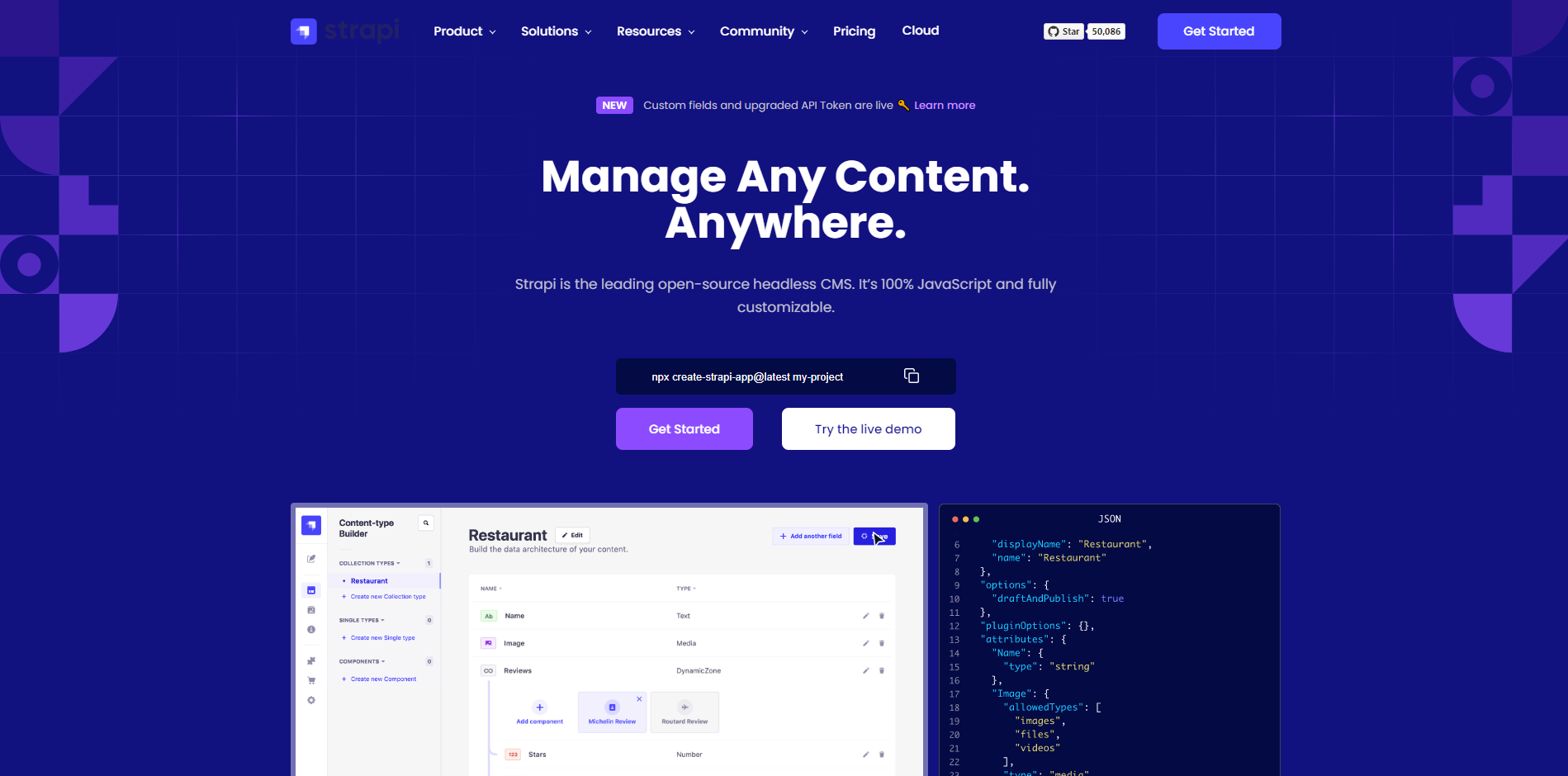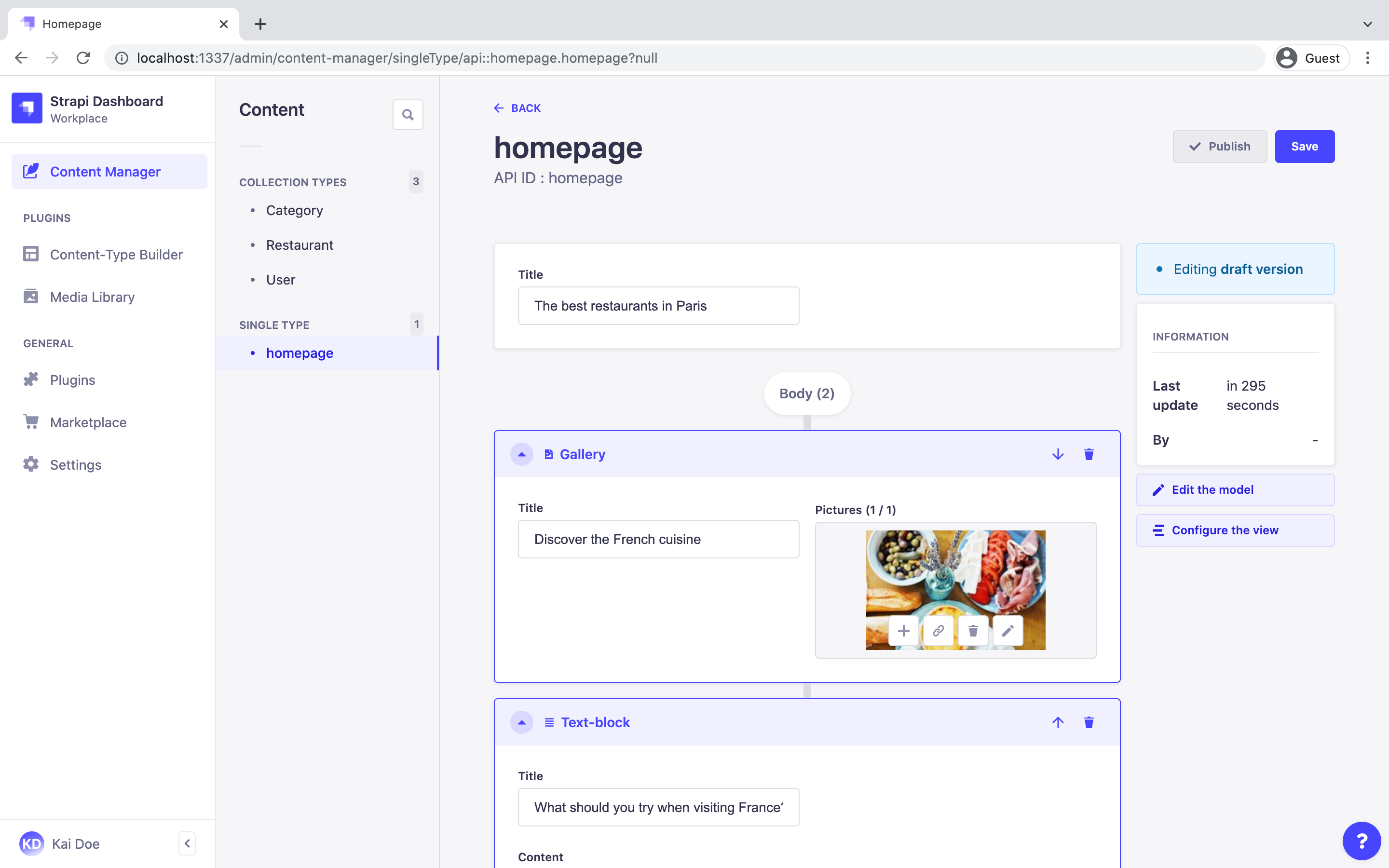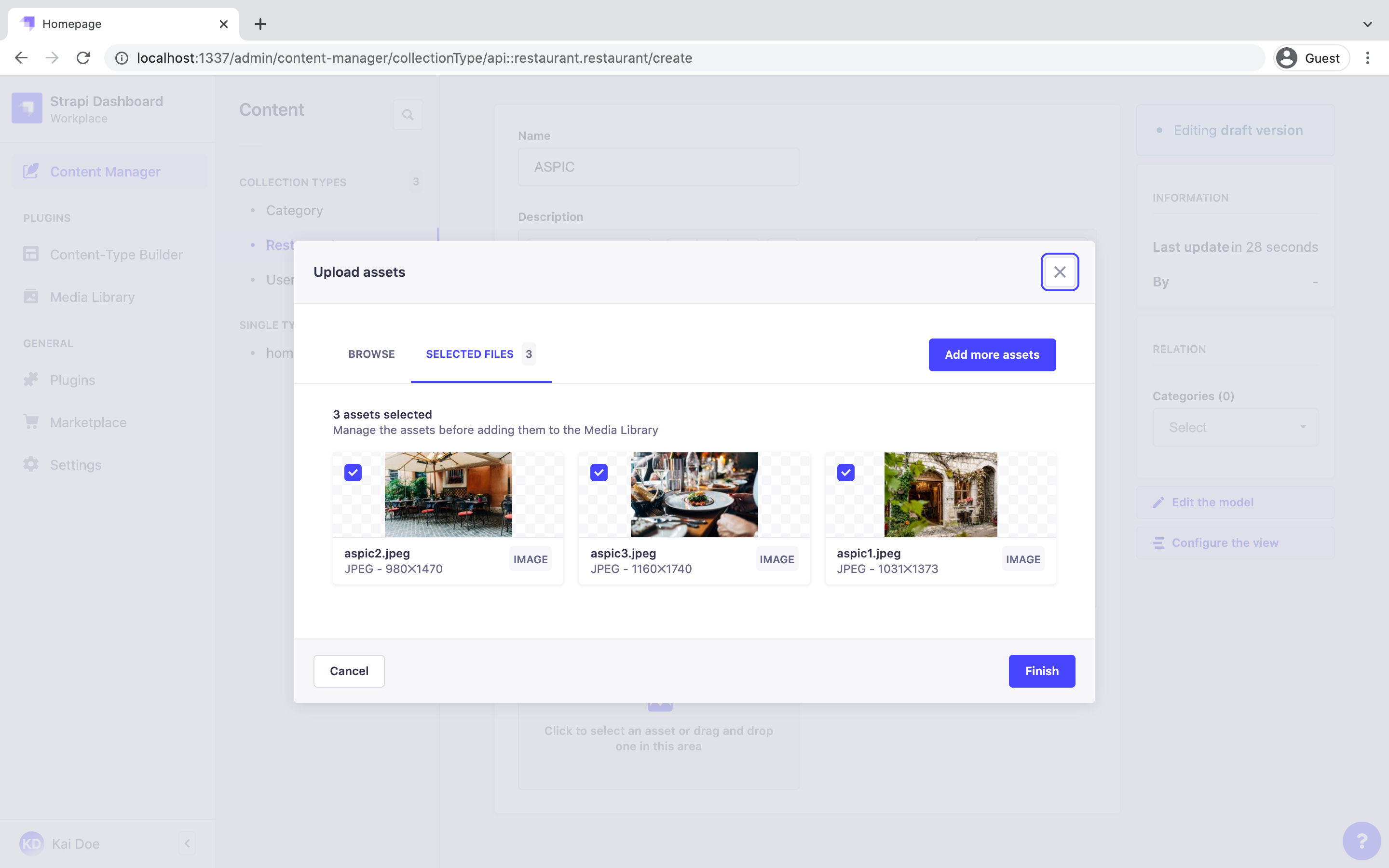

Strapi Reviews & Product Details
Strapi is a free, open-source, and headless/back-end-only CMS that runs on 100% Javascript. Made for developers, it’s fully customizable and provides a robust environment for creating self-hosted and high-performing content APIs. Content creators can easily define models to build rich layouts depending on the data structure they need for their business. Once a content architecture has been set, it’s seamless to write, edit, and manage any content type. Comprehensive frameworks and services from third-party vendors are available to reinforce the content environment and once ready, content can be easily deployed on all cloud platforms or traditional servers.
| Capabilities |
|
|---|---|
| Segment |
|
| Deployment | Cloud / SaaS / Web-Based, Desktop Linux, Desktop Mac, Desktop Windows, On-Premise Linux, On-Premise Windows |
| Support | 24/7 (Live rep), Chat, Email/Help Desk, FAQs/Forum, Knowledge Base, Phone Support |
| Training | Documentation |
| Languages | English |






Strapi is very easy to get started . It is one of the best CMS . The documentation is very clear and easy to undersatnd. It is open source so continuously growing.
The deployment is kind of tricky for strapi. There should be much support in strapi.
We are using strapi for headless CMS. It helps us managing and adding data.
The best thing about Strapi is that it is quite user friendly and anyone with a moderate education making changes to the backend of a website can do it without the need for a developer.
There's not much to dislike about Strapi just that it can have more functionalities.
Strapi solved the problem of having a Headless CMS with a great interface for us to easily modify the content on the website that we developed.
Strapi is built on a solid open source community and is both forward looking (via things like GraphQL) and well-established standards (such as REST). The latest version is also beautiful and easy to use.
Strapi Cloud has been slow to release. When we initially ran into installation problems and looked into a hosted version, we were disappointed that it was not yet available.
Strapi makes it easy to define and use many-to-many data relationships. One of the main problems Strapi has solved for us is providing an easy way for non-technical writers to leverage a complex data model.
Strapi helps us with the back-end solution. We want to develop a service with user authentication and a database. One possibility was to implement it from scratch, but then we got to the Strapi, which met all our needs. It provides an easy UI for creating DB and also for creating new users, roles, and also managing access rights. It is much simpler and safer for us to use Strapi than to implement this. It was super easy to install and very intuitive to start using. Also, DB schemas are clear, with no extra fields used by CMS itself.
Right now, we don't see a big downside to Strapi. We will see how hard it will be if we need to bend the code to our purposes. Till now, everything seems easy.
We want to build the service with back-end and front-end. It is much easier a safer to use Strapi than to implement the back-end by ourself.
Strapi has clear guidelines and is simple to use. It is very intuitive to design solutions, and as a headless CMS, it provides more functionality than any other CMS I have used.
The documentation that pertains to customisation can be made better. An Enhanced Rich content editor, as well as Support for a Greater Degree of Customization in Regards to WebHooks can further improve the experience.
I have a web application that I am managing the content of with the help of Strapi. We are relieved to be able to handle all of our content in a one location rather than across several different systems. The amount of time needed to construct solutions has decreased dramatically.
It just works! It's lightweight, extremely easy to set up, fast and highly customisable. We have built our application using Strapi together with NextJS and Postgres.
That granular permission control is not available in the free version of Strapi. This has been a slight hurdle when going to production for us.
We can finally decouple our data storage and management from our frontend. Wordpress is no longer needed. Instead, we have a beautiful NextJS/TailwindCSS application for our frontend.
Clean interface and power content type builder. Supports SQLite which makes it cheap to deploy to cloud
Lacks support for Microsoft SQL. Nothing else.
Saves a lot of time rather than implementing CRUD interfaces to all content pages of our website.
How quickly I was able to get up and running with secured REST endpoints
Nothing... so far. I build B2B SaaS products so I may grow to loathe the tax on Strapi's tier that offers SSO, as it's an essential feature to sell to the enterprise.
Strapi simplifies the effort to build a robust backend with its GUI tools to build out entities & generated code. Instead of spending weeks building the foundation to an application, I can bootstrap with Strapi and immediatly focus on the actual data entities and workflows.
Easy to setup The simplicity and effectiveness in content building (mostly) open source Nice documentation Active community
Somes spécifics features need to be customized and are not well documented there is no completely free plan available (as the admin user is limited in the free version).
I am creating a platform for Non profit organisation, and Strapi allows us to develop a front end easily and at low cost.
Strapi has made creating a highly flexible and powerful API very simple. Most basic functionality is very intuitive, and there's extensive documentation for more complex functionality.
The lack of granular access controls in the community plan reduces the usefulness in some use cases, but these are available in paid plans. Otherwise we haven't encountered any problems
Setting up a headless CMS for a non-profit organisation involving a number of stakeholders for a website with a Next.js frontend. Strapi has allowed us to build a CMS that is easy to use for non-technical users while still providing the complex functionality necessary for our website.
Front-end developers can focus solely on frontend.
Translation for the backend is not optimal, non-english speaking users may be lost when using it.
We used to have performances problems with our old CMS. Now we can use a fast frontend without losing benefits of a strong backend.
The best part of Strapi is that it is only opinionated where it is necessary, but is flexible in most other regards. I like how it is user friendly to editors, but has a great API (including GraphQL) so that developers are empowered, but it's also possible to build MacOS Shortcuts integrations.
One of the downsides is that the media library doesn't easily support internationalization, meaning that the built-in fields for captions and alt tags can not really be used, This creates the necessity to store this information on a different level, but this makes it difficult to create elements like carousels which are much easier to create if the alt tags and captions can be pulled from the media library.
Strapi will serve as the editorial content repository and admin interface for a museum and heritage foundation. it should support multiple frontends but also should let us fetch data to automatically generate email newsletters and other stuff.
It evolves quickly, the data model is editable easily and it’s very easy to use for everyone.
Like every generic tool, some corner cases must be avoided.
Creating a BackOffice to manage our website would have been time consuming without it.
With strapi it is straightforward to set up a project and get started quickly. It provides an API out of the box. Since it is an open-source project, it is very flexible and customizable. The community is helpful and strapi provides good documentation and frequent updates.
Some important features are missing out of the box, e.g., the possibility to export data. But so far, I was able to add most of the missing functionality with plugins. A lot of the documentation and other information is for v3, but the new v4 brought some changes, so you need to be aware of the differences between the two versions.
I am using strapi to build an interactive LMS for education. I use it for user management and basic CRUD operations to track user activity. It allowed me to set up a working API quickly and saved me hours of work. It also allowed me to reuse an existing website built with a javascript framework without many changes.
Easy to install and manage. Both ReST and Graphql API UI well designed
For now, no Docker image for version 4 No easy way to import and export data No tool to migrate from version 3 to version 4
Create an API in minutes.. For our students is very easy to use and install
- Strapi features a mordern, intuitive UI which even non technical users can easily use - great API, either using REST or/and GraphQL - ability to create custom custom, typesafe data types - mordern code base, fast performance, uses NodeJS - it is possible to self host Strapi which enable full control over the data. They even provide a docker image for easier hosting.
- limited access control using the community plan. While it does not matter for personal projects, using Strapi with multiple people may require a higher plan to get more granular access control. - less hosting options than Wordpress or other PHP based applications
I use Strapi as a headless CMS for storing and managing the content of our upcoming sporting club website. As Strapi is a headless CMS, it allows for decoupling the data (Strapi) and the layout & design (NUXT) of the website. It is easy to host and intuitive for other users to modify existing content or create new content to be displayed on the website
Seems like a great way to build API driven aps quickly.
I've encountered some bugs and some things seem to be more difficult than they have to be. It's definitely not plug and play. Strapi takes some time and patience to learn but once you understand how to setup a development and production environment - magical things start happening.
I'm using the app to improve internal communication at my university.
Strapi is an awesome product for quickly setting up CMS and API for your products. We started working with Strapi in Dec 2020. Since then, we have used Strapi in three of our projects. Basic things like Rate Limiting, Authentication, Roles and Permissions are pre-built into Strapi. If you know Strapi, you can set up your fully functional E-Commerce store in a day.
There are some technical issues that I am confident would be fixed in the next major release. One that comes to my mind is that context is not available in lifecycle hooks. Another thing I would want the Strapi team to consider is to make Strapi on Serverless environments. Also reducing the size of node modules can help a lot.
Setting up CMS for non-technical users was one of the biggest issues for our firm. It would cost our clients a lot of money, training sessions and time. After using Strapi, the cost is less, fewer frustrations and happy clients.
It's open-source, free, extendable, built with React, Javascript, Node... With the V4 version it has a new plugin ecosystem so anyone can easily contribute.
Sometimes it's a bit slow (haven't tested much V4 yet tough). I would also love some more custom fields (color picker, map...) ;)
It enables us to build private & secure CMS's for big and small clients really quickly.
Strapi was very simple to set up on my server. The admin part is clear and very efficient. Authentication and roles are time-saving. The documentation is very helpful, I used the nginx with subdomain part, the process was easy. I love it!
I haven't seen drawbacks yet. Maybe adding documentation or example about a frontend in React Typescript, deployed as a Static Web App on Azure using Strapi as the API through Azure Functions.
Having a simple and efficient API with authentication/authorization for my Ionic React mobile projects and my websites. I use Strapi for my Cinder C++ shader mixer app, so I can store shaders, settings, etc.









